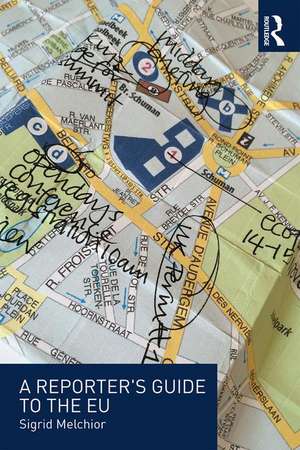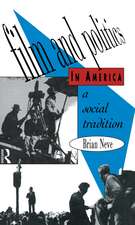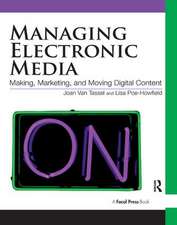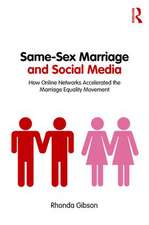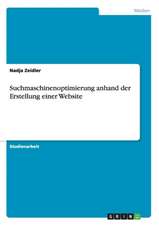A Reporter's Guide to the EU
Autor Sigrid Melchior Editat de Stephen Gardneren Limba Engleză Paperback – 9 mai 2017
Sigrid Melchior, an experienced Brussels-based journalist, gives a detailed overview of the main EU institutions and explains the procedures for passing EU law. Interviews with professionals working for the EU, from areas including lobbying, public relations, diplomacy and journalism, are featured throughout the book.
Building on this, the second half of the book provides useful journalistic tools and tips on how to approach EU reporting. It identifies common mistakes in reporting on the EU and how to avoid them, as well as offering guidance on investigative reporting. Melchior also details how to work with information gathered and maintained by EU institutions, including their audiovisual archives, the Eurostat and Eurobarometer, which are invaluable resources for journalists and journalism students.
With few aspects of political life that remain untouched by EU decision-making the book demystifies the EU system and its sources, enabling professional journalists and students of journalism to approach EU reporting with clarity and confidence.
For additional resources related to A Reporter’s Guide to the EU, please visit www.areportersguidetotheeu.com
| Toate formatele și edițiile | Preț | Express |
|---|---|---|
| Paperback (1) | 310.34 lei 6-8 săpt. | |
| Taylor & Francis – 9 mai 2017 | 310.34 lei 6-8 săpt. | |
| Hardback (1) | 769.00 lei 6-8 săpt. | |
| Taylor & Francis – 10 mai 2017 | 769.00 lei 6-8 săpt. |
Preț: 310.34 lei
Nou
Puncte Express: 466
Preț estimativ în valută:
59.38€ • 62.17$ • 49.14£
59.38€ • 62.17$ • 49.14£
Carte tipărită la comandă
Livrare economică 05-19 aprilie
Preluare comenzi: 021 569.72.76
Specificații
ISBN-13: 9781138678637
ISBN-10: 1138678635
Pagini: 300
Dimensiuni: 156 x 234 x 22 mm
Greutate: 0.47 kg
Ediția:1
Editura: Taylor & Francis
Colecția Routledge
Locul publicării:Oxford, United Kingdom
ISBN-10: 1138678635
Pagini: 300
Dimensiuni: 156 x 234 x 22 mm
Greutate: 0.47 kg
Ediția:1
Editura: Taylor & Francis
Colecția Routledge
Locul publicării:Oxford, United Kingdom
Public țintă
Professional Practice & DevelopmentCuprins
Preface, Acknowledgements, Part I Introduction, Chapter 1: Introduction to EU reporting Chapter 2: A few tips and tricks to get started Chapter 3: What, really, is the EU?, Part II The three main EU institutions, Chapter 4: The European Commission, The commissioners and their portfolios, The European Commission as a source, What the European Commission does Chapter 5: The European Parliament, The MEPs, Party groups, Committees, Plenary sessions, MEPs' performances, What the European Parliament does Chapter 6: The Council of Ministers and the European Council, The council formations, The permanent representation: the national governments in Brussels, The rotating presidency of the council, Council of Ministers press office and website, The decision-making process in the Council of Ministers, The European Council, Part III Decision-making in the EU, Chapter 7: The legislative process part I: The European Commission proposes a new law Chapter 8: The legislative process part II: The European Parliament and the Council of Ministers amend and adopt the law, Special legislative procedures, The ordinary legislative procedure Chapter 9: Tools for following the legislative process Chapter 10: Delegated decision-making, Part IV Other EU sources, Chapter 11: Other EU institutions, European External Action Service, EEAS, Court of Justice of the European Union, The European Central Bank, Court of Auditors, OLAF: the EU’s counter-corruption agency, The European Economic and Social Committee and the Committee of the Regions, Decentralized EU agencies Chapter 12: Statistics, opinion polls, sound, photo and video, Eurostat, Eurobarometer, Photo, audio and video from the EU institutions Chapter 13: Lobbying Chapter 14: Think tanks and research Chapter 15: Media, Part V Practical EU reporting, Chapter 16: Bringing the EU home, Making the connection between Brussels and home, Holding your politicians accountable, Specialist journalist? Integrate the EU into your reporting, Consumer journalism, Men and women – who are your sources? Chapter 17: Common mistakes in EU reporting and how to avoid them Chapter 18: Investigative EU reporting, The state of investigative EU reporting, Investigating EU spending, Investigating lobbying, conflicts of interests and corruption in the EU, Access to documents in the EU, Whistleblowers Chapter 19: Practical help in Brussels, Accreditation to the EU institutions, When in Brussels, Journalist organizations Chapter 20: Writing about the EU Glossary Index
Recenzii
Gregory Paschalidis, School of Journalism and Mass Communications, Aristotle University of Thessaloniki, Greece – ‘The author has significant professional experience in EU coverage, and is thus in a position to offer an insider's perspective on the field […] The author succeeds in covering the different facets of the subject in a succinct, yet comprehensive and well-ordered manner […] Face-to face contact with distinguished professionals has its own rewards, but a well-thought out and comprehensive Handbook is equally invaluable.’
Dr. Peter Anderson, School of Journalism, Language and Communication, University of Central Lancashire, UK – ‘This is a book that will be of interest to those journalists who have a genuine commitment to accuracy and getting at the full facts and who are prepared to take the time to read it. It will be of use on university journalism courses where students have no relevant modules in politics/economics as part of their programme of study […] it is the kind of book where course teams may well recommend libraries to buy several copies, e-versions, etc.’
Carien J. Touwen, Journalism and Media Studies, HU Utrecht University of Applied Sciences, The Netherlands – ‘It sounds very practical and I think that will serve us well. I do find the title a bit confusing, it seems to be more about Reporting on the EU and Reporting from Brussels, than EU Journalism, whatever that might be […] Most chapters seem quite complete. However I would suggest to keep the chapters on EC, EP and Council of Ministers short. Stick to the practical side of it and leave the boring ‘how does it all work in detail’ to other handbooks on the EU. Chapter on Investigative journalism should also deal with the ‘access of information’ and issues with ethics and other difficulties.’
Claes de Vreese, Political Communication, The Amsterdam School of Communication Research, University of Amsterdam, The Netherlands – ‘The overall idea behind this book is good. It is useful to have a resource helping journalists how to ‘report on the EU’. It is true that much of the academic literature is not easily accessible and much of the official information hard to find. However, one wonders who the real market is […] Part 5 of the book is by far the most exciting one. In my view, that should be the book! This is where we –finally- transform into looking at actual journalism, the dilemma’s on when to report in decision cycle, how to link EU news to domestic politics, how to conduct investigative reporting, and how to spot some of the nonsense in EU reporting. These chapters make up about 50 pages of the book but it is really what it is all about and where the real contribution is.’
Dr. Peter Anderson, School of Journalism, Language and Communication, University of Central Lancashire, UK – ‘This is a book that will be of interest to those journalists who have a genuine commitment to accuracy and getting at the full facts and who are prepared to take the time to read it. It will be of use on university journalism courses where students have no relevant modules in politics/economics as part of their programme of study […] it is the kind of book where course teams may well recommend libraries to buy several copies, e-versions, etc.’
Carien J. Touwen, Journalism and Media Studies, HU Utrecht University of Applied Sciences, The Netherlands – ‘It sounds very practical and I think that will serve us well. I do find the title a bit confusing, it seems to be more about Reporting on the EU and Reporting from Brussels, than EU Journalism, whatever that might be […] Most chapters seem quite complete. However I would suggest to keep the chapters on EC, EP and Council of Ministers short. Stick to the practical side of it and leave the boring ‘how does it all work in detail’ to other handbooks on the EU. Chapter on Investigative journalism should also deal with the ‘access of information’ and issues with ethics and other difficulties.’
Claes de Vreese, Political Communication, The Amsterdam School of Communication Research, University of Amsterdam, The Netherlands – ‘The overall idea behind this book is good. It is useful to have a resource helping journalists how to ‘report on the EU’. It is true that much of the academic literature is not easily accessible and much of the official information hard to find. However, one wonders who the real market is […] Part 5 of the book is by far the most exciting one. In my view, that should be the book! This is where we –finally- transform into looking at actual journalism, the dilemma’s on when to report in decision cycle, how to link EU news to domestic politics, how to conduct investigative reporting, and how to spot some of the nonsense in EU reporting. These chapters make up about 50 pages of the book but it is really what it is all about and where the real contribution is.’
Descriere
A Reporter’s Guide to the EU addresses a pressing need for an effective, in-depth guide to reporting on this major governing body, offering practical advice on writing and reporting on the EU and a clear, concise breakdown of its complex inner-workings.
Sigrid Melchior, an experienced Brussels-based journalist, gives a detailed overview of the main EU institutions and explains the procedures for passing EU law. Interviews with professionals working for the EU, from areas including lobbying, public relations, diplomacy and journalism, are featured throughout the book.
Building on this, the second half of the book provides useful journalistic tools and tips on how to approach EU reporting. It identifies common mistakes in reporting on the EU and how to avoid them, as well as offering guidance on investigative reporting. Melchior also details how to work with information gathered and maintained by EU institutions, including their audio-visual archives, the Eurostat and Eurobarometer, which are invaluable resources for journalists and Journalism students.
With few aspects of political life that remain untouched by EU decision-making the book demystifies the EU’s bureaucratic systems and sources, enabling professional journalists and students of Journalism to approach EU reporting with clarity and confidence.
Sigrid Melchior, an experienced Brussels-based journalist, gives a detailed overview of the main EU institutions and explains the procedures for passing EU law. Interviews with professionals working for the EU, from areas including lobbying, public relations, diplomacy and journalism, are featured throughout the book.
Building on this, the second half of the book provides useful journalistic tools and tips on how to approach EU reporting. It identifies common mistakes in reporting on the EU and how to avoid them, as well as offering guidance on investigative reporting. Melchior also details how to work with information gathered and maintained by EU institutions, including their audio-visual archives, the Eurostat and Eurobarometer, which are invaluable resources for journalists and Journalism students.
With few aspects of political life that remain untouched by EU decision-making the book demystifies the EU’s bureaucratic systems and sources, enabling professional journalists and students of Journalism to approach EU reporting with clarity and confidence.
